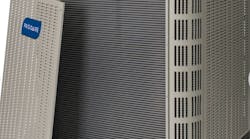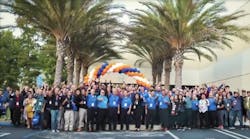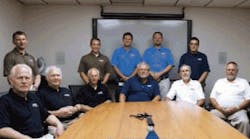When you manufacture HVACR products that many may see as a commodity, how do you demonstrate the value of your products and the value of your company to customers? For KMC Controls, a manufacturer of controls, actuators and valves, the answer lies in its tagline: In Touch.
Since the company was founded as Kreuter Manufacturing Co. in 1970 by Ken Kreuter, the company has lived by this short and simple message, which it only recently began using in its advertising and marketing. Because when a small manufacturer like KMC Controls, a privately held company, competes with multinational companies in a global market, remaining "in touch" with customers and their needs can be a significant differentiator.
The message of being in touch came through loud and clear as company executives spoke with customers, says Ben Dorsey, KMC Controls' vice president of marketing. From responding to the needs and wants of its customers to being involved in industry initiatives, KMC Controls' operating philosophy has always been about remaining "in touch." While price will always be a factor, the connections that the employees of KMC Controls have established with its customers and with industry partners over the years count among the major drivers of the company’s success. "The connection to people, understanding their needs, trust in business relationships and the ease with which we can do business together are the things that will help us secure our future," Dorsey says.
The company made KMC Controls the new name in 1995 because it better reflected the HVACR industry that it serves. Still, Kreuter Manufacturing Co. remains a well-known brand among wholesaler distributors and their customers; many still refer to the company as "Kreuter," Dorsey says. KMC Controls also continues to carry its legacy line of pneumatics that many refer to as "Kreuter." In fact, Ken Kreuter designed and patented the easily recognizable reset volume controller, which still accounts for continued and strong sales in the replacement market.
When a company has that kind of name recall and recognition among customers, it speaks volumes about the loyalty that its products have engendered. When Kreuter first established his manufacturing company in Winnipeg, Manitoba, he operated out of a three-car garage. The company's products, which included damper actuators, pneumatic-electric switches and logic relays, were marketed through private labels. In the 1970s, Kreuter moved his operations to Minnesota. It was during this time that he expanded the line to include variable air volume controllers and actuators, becoming the leading private label supplier to some of the world's top control manufacturers.
In 1978, the company moved its manufacturing operations to a 4,000-square-foot facility in New Paris, IN, where it is located today. Over the years, KMC Controls has expanded its operations, growing into a 100,000-square-foot facility. During previous years, KMC Controls also has expanded its business to include a complete line of fully programmable digital hardware and intuitive software for local and remote web-based facility management.
The Indiana facility serves as KMC Controls' headquarters as well as its manufacturing plant. Yes, KMC Controls proudly manufactures its products in the United States. Dorsey says the company considered moving part of its manufacturing operations overseas about 10 years ago to save costs, but they stayed in Indiana for two reasons. "The owners of this company are very committed to staying here. It's very much a family atmosphere, and the desire to move simply was not that high," he says. "In addition to that, there's not a whole lot that we do that would be considered high volume, low mix, which is more conducive to offshore manufacturing."
The provision in last year's American Reinvestment and Recovery Act, the stimulus package approved by Congress, that provides funds for projects that use American-made goods has been a boon to KMC Controls. "We have had numerous sales as a result and numerous inquiries regarding this," Dorsey says. Even when Recovery Act funds have not been part of the equation, many construction managers prefer to go with American-made products.
Page 2 of 3
Contractors and engineers and their wholesaler distributors have come to rely on KMC Controls' wide range of pneumatics, actuators and controls. The company serves only the commercial and institutional markets, and its salespeople also work with building engineers, architects and contractors on specifications and project bids. The wholesale channel represents an important 25 percent of KMC Controls' business, with the remainder going through the OEM channel and the contracting channel. One has to simply browse the company’s website (www.kmccontrols.com) to understand the product mix and the number of new and updated products that they continue to add to their inventory.
KMC Controls bases its excellence on engineering, and Dorsey notes that most of the 14 founding family members who work at the company got their start on the engineering side. There are a number of engineering teams, including software and firmware design engineers, manufacturing engineers, test & validation engineers and engineers in management positions.
Their R&D receives its guidance from the company's Product Approval Committee. Consisting of members of the senior management team, the Product Approval Committee meets every two weeks to determine project priorities and review project schedules to ensure that the work is moving forward. "This committee guides all states of product development and life—cradle to grave," Dorsey says. "In essence, our senior management team performs the market research function to ensure that the right products are being designed and enhanced."
KMC Controls works off of a strategic plan that it updates every two to three years. "Years ago, we would have done this every five years and been content with it," Dorsey says. "But the dynamics of the marketplace have changed so rapidly that we need to change every couple of years." In a market that evolves constantly, KMC Controls wants to be sure it keeps its pulse—and stays in touch—with the industry and what its customers are thinking.
As part of developing their strategic plan, members of the senior management team meet with customers to get a sense of the bigger picture. The conversation is not about controls or actuators, but about their business and the HVACR business as a whole. "What is happening in their world? What are the business pressures that they’re under? What are the trends that they're seeing? We'll take that information and formulate it as part of our strategy," Dorsey says.
While the voice of the customer interviews conducted by members of the senior management team focuses on the big picture, KMC Controls sales staff work with its wholesaler distributors on the day-to-day issues. The vice president of sales oversees five regional sales managers, who are responsible for all the accounts within their regions, including wholesaler distributors, system distributors and commercial controls contractors. KMC Controls' customer service department acts as an inside sales team. "Our customers give us extremely high marks for our customer service excellence," Dorsey notes.
KMC Controls has developed long-term relationships with its wholesaler distributors. The company says its strongest customers understand that they have to move forward and evolve—much like it has done. Every distributor needs to evaluate its needs—from a strategic and tactical point of view—to determine how they can best adapt their business model to a changing world. "That could mean more of an Internet presence; it could mean a move to 'parts and smarts,'" Dorsey says. Or as one of KMC Controls' customers explained the secret of their success to Dorsey: We find a way to say yes when our competitors say no. Says Dorsey: "I can tell you that this approach is working amazingly well."
Page 3 of 3
In a move to save on costs, some distributors have shifted their inventory burden back to the manufacturers. While that may save in the short term, the long-term results can be lethal when the parts that a customer needs are not in stock. "That's the No. 1 complaint I hear from HVACR contractors: 'They just don’t have it in stock.'"
The folks at KMC Controls smile when they hear companies tout their "green" initiatives and sustainability projects. KMC Controls has designed its products to optimize the operations of equipment and systems, and that leads to lower operational and maintenance costs as well as higher energy efficiency.
KMC Controls takes this one step further. The company has been a member of the U.S. Green Building Council for years, and Dorsey is a LEED Green Associate. He sits on the Exhibitor Advisory Working Group of the Greenbuild show, which KMC Controls has exhibited at since 2005. Others on the staff are LEED accredited, and there is a push within the organization to credential all of the sales team members. "Our products, along with the services provided by our channel partners, have helped numerous buildings around the world operate more efficiently and have helped many achieve LEED certification," Dorsey says. KMC Controls' products contribute credits to the water efficiency, energy and atmosphere and indoor environmental quality categories for the LEED rating system for buildings, he says.
Dorsey says building owners, property managers and facility managers are demanding higher levels of efficiency in their buildings and new construction projects. "They want to see numbers about payback for any significant capital enhancement that they make," he says. "Wholesaler distributors should understand what drives demand. If their contractor customers aren't in tune with these issues, the distributors should help to drive the points home to them."
Dorsey foresees hardware and software continuing to be augmented with energy-related data to help end users make energy management decisions. For example, net-zero energy usage for buildings and related sustainability initiatives will continue to drive product innovation and building service providers.
He would like to see greater cohesion among all parties involved in building design, construction and operations. While team design, particularly in the development of green buildings, has become more accepted, he still sees "functional silos and a lot of grenades going back and forth" within the contracting community. HVACR and controls contractors and systems integrators often get the short end of the stick, he adds.
But Dorsey does not take a defeatist attitude. Not by a long shot. For he sees opportunity everywhere for control contractors and wholesaler distributors who are savvy and willing to evolve and take smart risks. After all, KMC Controls is in a market surrounded by giants, but the company chooses not to hide in a corner. "We are active HARDI members, we advertise, we have a significant web presence, we exhibit at several events each year and we participate on industry committees," Dorsey says. KMC Controls and its people have built on their strengths, showing the industry there is a place for smaller manufacturers who are there for customers, meet their needs and deliver quality products made in the United States.
Michael Maynard is a business writer based in Providence, RI. He writes frequently on HVACR, construction and architecture issues. Contact him at [email protected].
Best Practice
Voice of the Customer (VoC)
Definition: A practice used in conjunction with our strategic planning (every two to three years) to garner the insights of customers through visits with a fixed purpose.
Significance: To focus our planning and ensure proper investments in future product developments and service offerings, we look at both market data and customer insights. VoC represents the insights.
Benefits: VoC forces us to question our assumptions. It raises our collective awareness of real-world issues, concerns and trends. It impresses customers and fosters loyalty when they see a manufacturer listening so intently.
People involved: It's dynamic but always includes four to six members of the senior staff representing a cross-functional team.
Procedure: (1) We select 20 to 30 customers who represent thought leadership, emerging markets, geographic priority or a particular segment of the industry we want to grow. (2) We create a discussion guide around the particular customer or customer type. (3) We contact these customers to arrange for in-person visits, telling them we need about two hours of their time. (4) We inform them that the visit will NOT be a sales call and that we will not discuss products. Rather, we are there to gather their market insights and to understand their business issues. (5) We take a cross-functional team to the appointment and conduct a somewhat formal interview using the discussion guide. (6) One person moderates the discussion, one is assigned as note taker, and the other team members are quiet observers. (7) We debrief afterward and help the note taker focus their notes. (8) The note taker sends a copy of the notes to the customer for review and shares the final notes with the management team.
Contact: Ben H. Dorsey III, vice president of marketing & communications, 574.831.8187, [email protected].









